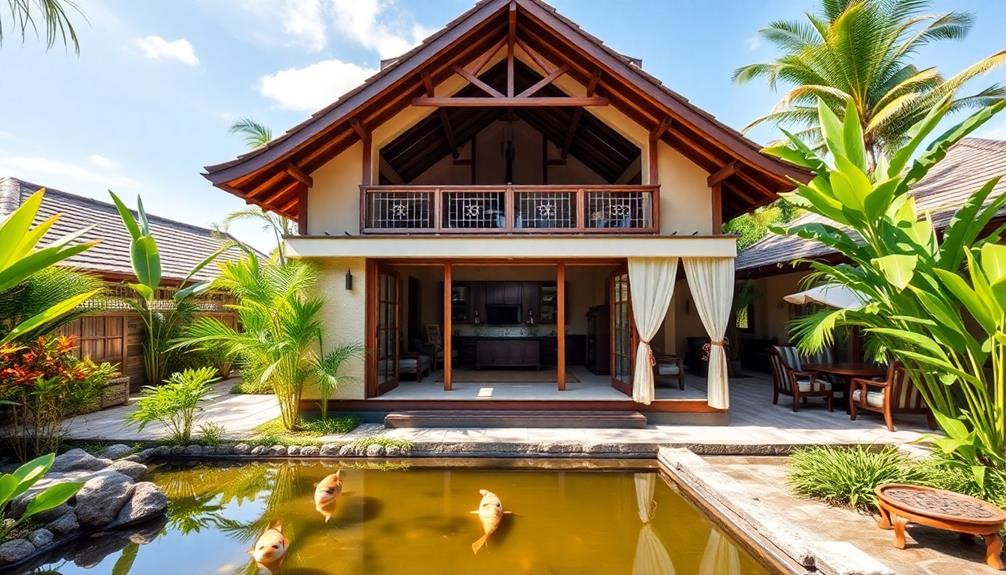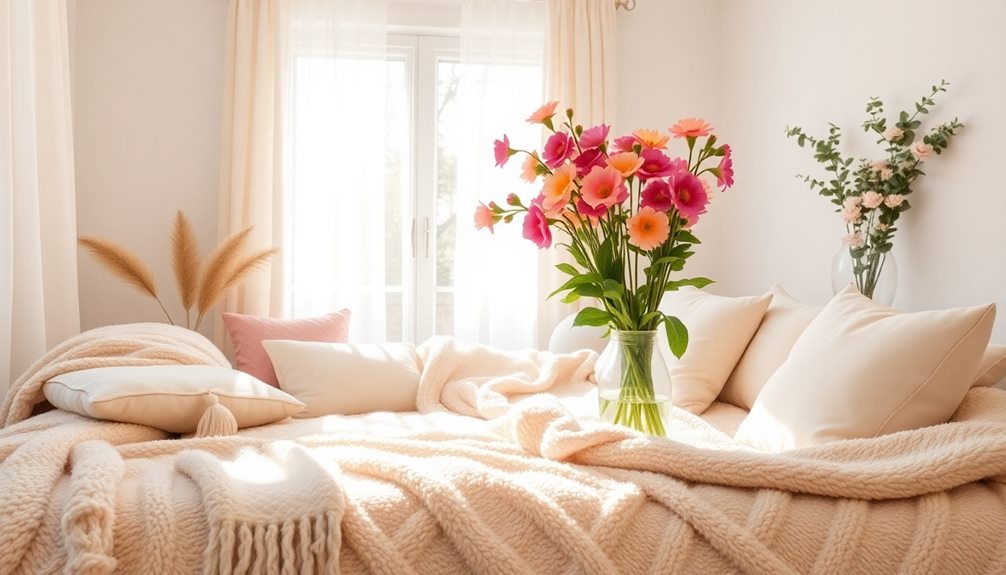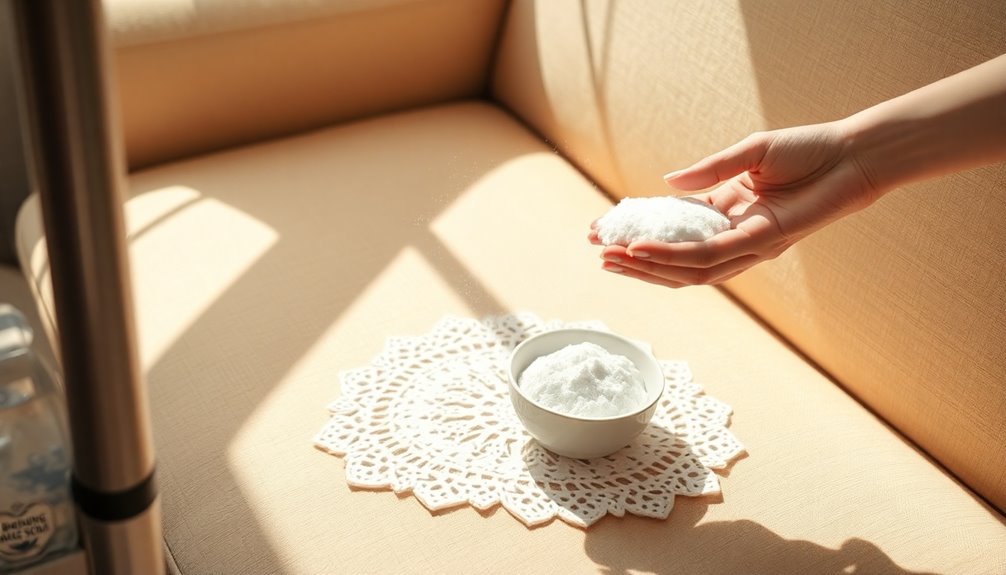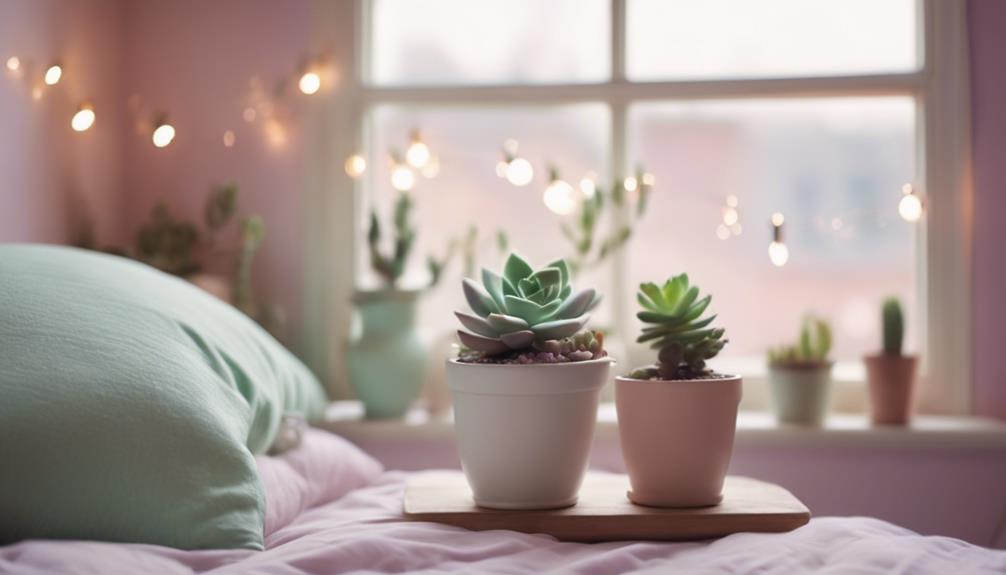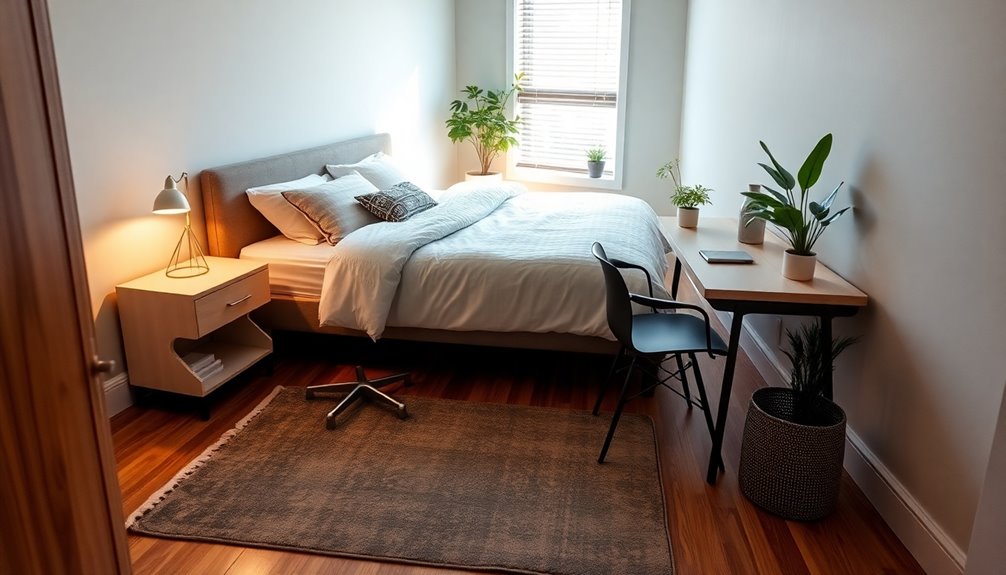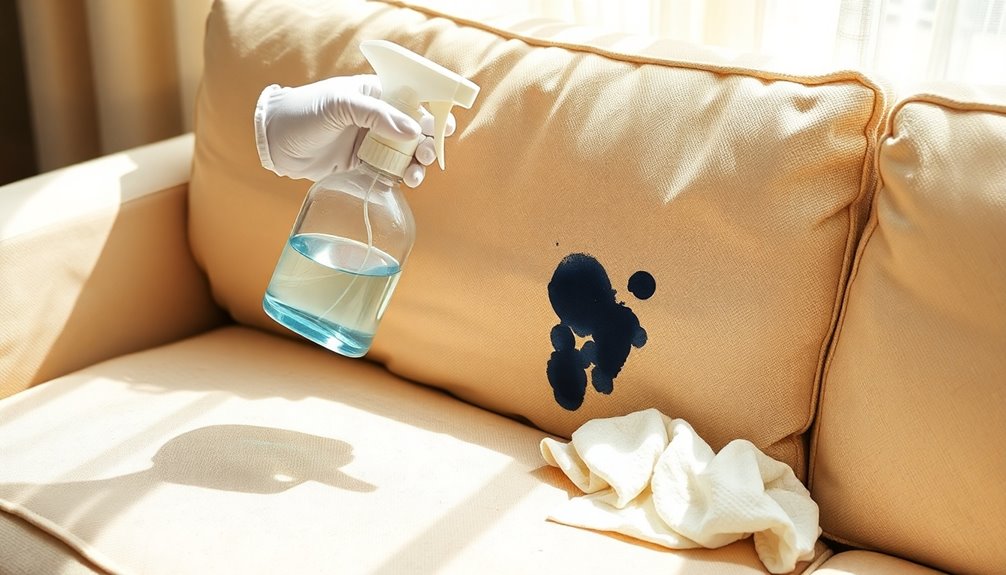You can turn your house into a serene sanctuary by embracing Balinese style. Begin by integrating natural materials such as wood, bamboo, and stone to create a warm atmosphere. Stick to an earthy color scheme with whites, browns, and greens, adding pops of color for a lively touch. Design spacious layouts that blur the lines between indoors and outdoors, allowing for better airflow and natural light. Include calming water features to represent tranquility and harmony. By combining these components, you’ll achieve a luxurious yet peaceful ambiance. As you delve deeper, you’ll uncover additional strategies to master this style.
Key Takeaways
- Incorporate natural materials like wood, bamboo, and stone to create a serene and luxurious atmosphere in your home.
- Design open floor plans that promote indoor-outdoor integration, enhancing natural light and airflow for tranquility.
- Use an earthy color palette with vibrant accent colors to establish a calming yet lively ambiance throughout your space.
- Include water features, such as fountains or ponds, to symbolize tranquility and enhance the overall aesthetic of your home.
- Embrace eco-friendly practices and sustainable materials to align with Balinese philosophy and promote energy efficiency in your design.
Overview of Balinese Design Principles
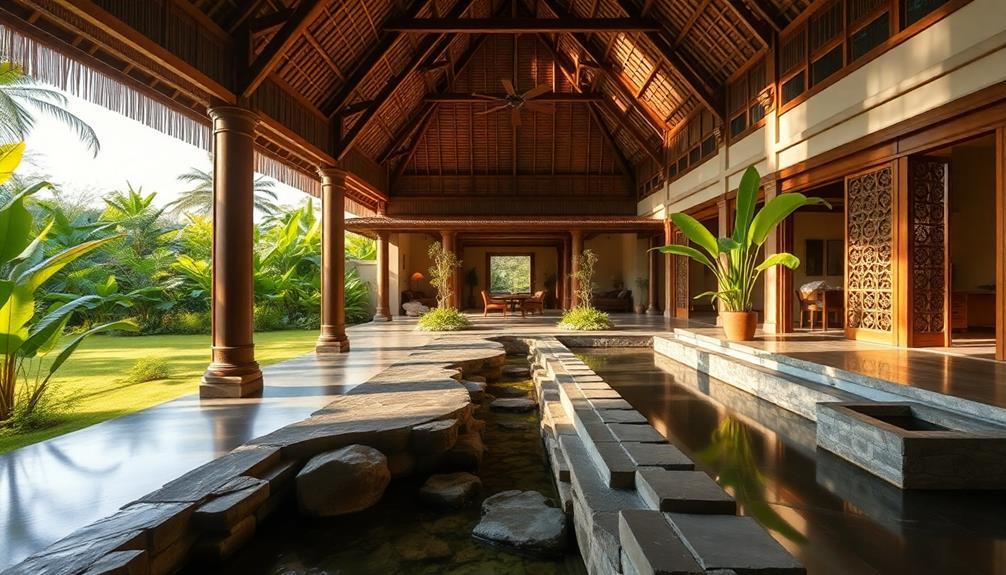
In Balinese design, the emphasis on natural materials like wood, bamboo, and stone creates a seamless connection with the environment around you. These elements not only enhance the aesthetic appeal but also foster a sense of harmony and tranquility within your living space.
The integration of indoor-outdoor elements further enriches this connection, allowing nature to become a part of your home. Open floor plans play a vital role in this design philosophy, allowing natural light to flood in and promoting airflow, which keeps your home feeling fresh and inviting.
The color palette, dominated by earthy tones such as whites, browns, greens, and terracotta, complements the natural materials, creating a serene atmosphere. You can add splashes of vibrant colors from tropical plants to breathe life into the space.
Water features, like ponds or fountains, are essential in Balinese design, symbolizing tranquility and fertility while enhancing the peaceful ambiance.
Essential Materials for Balinese Decor
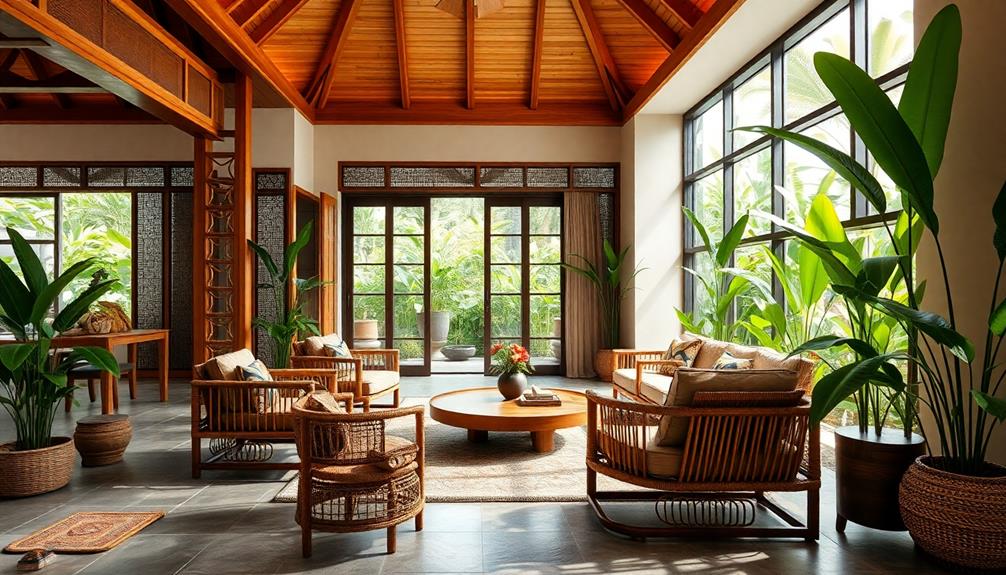
Natural materials are the cornerstone of Balinese decor, creating spaces that resonate with beauty and tranquility. To achieve this aesthetic, focus on incorporating bamboo and rattan, two materials that bring both functionality and style to your home.
Bamboo's sustainability makes it a popular choice for structural elements and decorative items like lampshades and furniture. Rattan, with its rich history in Bali, is often used in modern furnishings, providing lightweight, stylish options perfect for any setting.
Additionally, you can enhance your decor with vibrant textiles such as Indonesian Decorative Pillows, which add comfort and cultural richness.
Don't overlook the charm of intricate wood carvings, which reveal the cultural significance found in Balinese craftsmanship. These carvings can add depth and character to your decor, often depicting scenes from local mythology.
Lastly, consider the role of natural textures in your design. Smooth stones, rough woods, and soft fabrics can be layered to create a warm and inviting atmosphere.
Cultural Significance of Wood Carvings
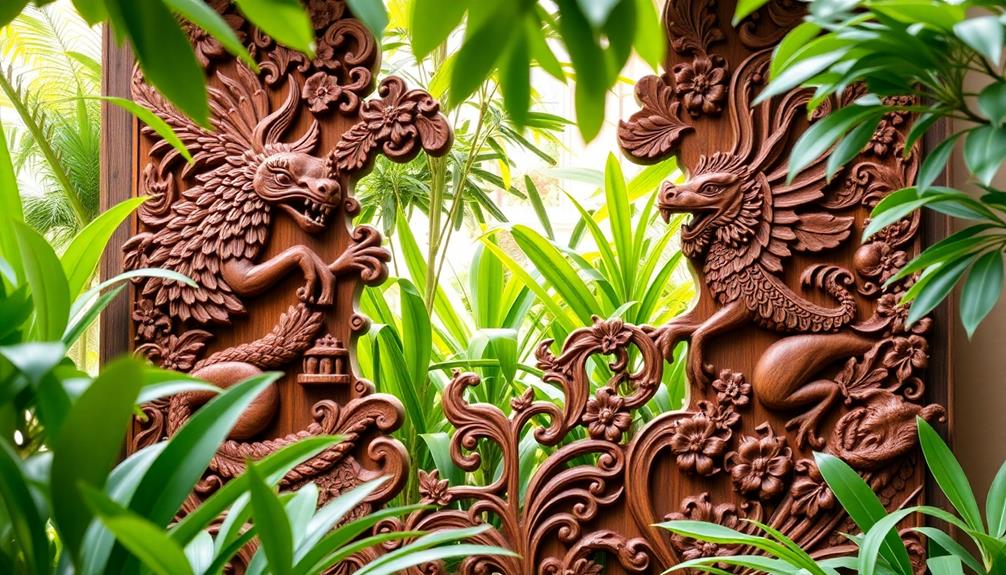
Wood carvings in Balinese decor aren't just decorative elements; they embody the island's rich spiritual heritage and cultural identity.
These intricate Balinese wood carvings serve as cultural focal points, often depicting Hindu deities and mythological creatures. Dating back to the arrival of Hinduism in the eighth century, these carvings play a crucial role in religious ceremonies and rituals, reflecting the Tri Hita Karana philosophy that emphasizes harmony among humans, nature, and the divine.
Additionally, Balinese artisans often incorporate elements of traditional craftsmanship, such as the vibrant designs seen in Indonesian decor masks, to further enhance the cultural significance of their work.
Imagine:
- A majestic wooden gate adorned with intricate patterns, welcoming guests with a sense of reverence.
- Elegant furniture pieces carved from local woods, showcasing the artistry and craftsmanship of Balinese artisans.
- Stunning wall panels that tell stories of spirituality and nature, infusing your home with tranquility.
Using local woods like teak and mahogany, artisans create detailed carvings that enhance the aesthetic appeal of your space while carrying deep symbolic meanings.
Balinese Color Palette and Textures
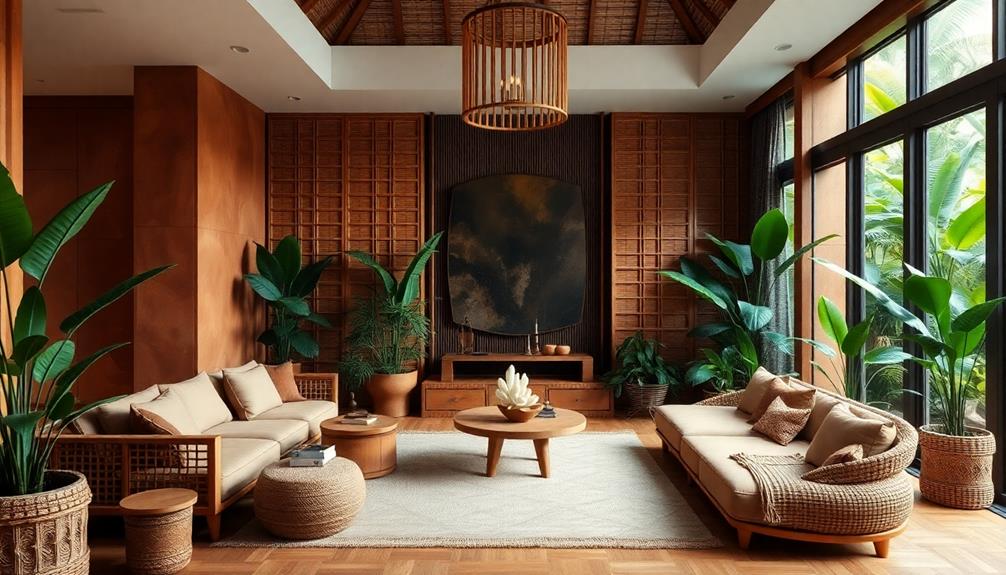
When you think about a Balinese color palette, earthy tones like whites, browns, and greens come to mind, creating a calming backdrop.
These colors echo the natural landscapes and promote a sense of harmony with the environment, which is essential in traditional Indonesian style home decor.
You can enhance this serene vibe with vibrant accent colors inspired by tropical flowers, adding energy to your space.
Layering different textures, from smooth stones to rough wood, not only enriches the aesthetic but also invites a tactile experience into your home.
Earthy Tones Emphasis
The Balinese color palette embraces warm, earthy tones that instantly create a serene atmosphere in your home. Imagine walking into a space adorned with soothing whites, rich browns, soft greens, and terracotta hues that echo Bali's natural landscape.
These earthy tones not only promote tranquility but also invite a sense of harmony with nature. To achieve a truly authentic aesthetic, you might consider consulting with experts in expert tropical design who can guide you through the nuances of blending these colors effectively.
To enhance this serene vibe, consider incorporating:
- Smooth stones that blend effortlessly with rustic wood elements
- Soft fabrics that add warmth and comfort to your furnishings
- Lush greenery that brings the beauty of the outdoors inside
Natural materials like teak and suar wood are essential in achieving the Balinese design aesthetic. Their rich textures and warm colors evoke rustic landscapes while enhancing the depth of your interiors.
Layering different materials, such as combining raw wood flooring with stone accents, creates visual interest and promotes a seamless shift between indoor and outdoor spaces.
Vibrant Accent Colors
Incorporating vibrant accent colors into your Balinese-style home can transform the serene ambiance into a lively oasis. By layering these colors with your existing earthy tones, you can create a dynamic yet harmonious space. Think rich reds, sunny yellows, and deep blues that reflect the tropical flora around you. These vibrant accent colors can be introduced through textiles and decor elements, adding character and warmth to your Balinese home decor.
Here's how you can visualize the color palette:
| Color | Decor Elements |
|---|---|
| Rich Red | Throw pillows, wall art |
| Sunny Yellow | Rugs, vases |
| Deep Blue | Curtains, table runners |
| Earthy Green | Plants, woven baskets |
Natural fibers like rattan and bamboo can complement these vibrant accents, enhancing the organic feel while maintaining the core color palette. Seasonal updates with fresh textiles or accent pieces allow you to keep your decor lively without straying from the Balinese aesthetic. Embrace the natural beauty of your surroundings and let vibrant accent colors breathe life into your sanctuary.
Textural Layering Techniques
Balinese homes thrive on textural layering, creating a rich tapestry that draws you in and connects you to nature. By combining various natural materials and earthy tones, you can achieve a serene and luxurious atmosphere.
Incorporate elements that evoke the essence of Balinese culture while enhancing your interior spaces. Consider these ideas to enrich your design:
- Smooth stones underfoot for a calming effect
- Rough wood accents that introduce a rustic ambiance
- Soft textiles featuring vibrant patterns that celebrate local artistry
Utilizing tropical-themed luxury interior design can elevate your approach, allowing you to create unique spaces that resonate with the beauty of Bali. This design approach blends natural materials, earthy tones, and lush greenery to emulate the serene atmosphere of a tropical paradise. By incorporating Bali style interior design photos into your planning and inspiration process, you can draw ideas from authentic Balinese aesthetics to craft spaces that exude comfort and elegance. With the right balance of textures, patterns, and lighting, your interiors can transport anyone to an exotic getaway without ever leaving home.
Using a palette dominated by whites, browns, greens, and terracotta, you can create harmony while adding pops of color with accents inspired by the tropical flora, like reds and yellows. The textural layering achieved through these combinations not only adds depth and visual interest but also promotes a sense of tranquility.
Furniture made from teak and suar wood can ground your space, while stone accents can mimic stunning beach scenes. To maintain freshness, adjust your textiles seasonally, allowing vibrant patterns to breathe new life into your home while keeping the Balinese vibe intact.
Modern Integration of Balinese Style
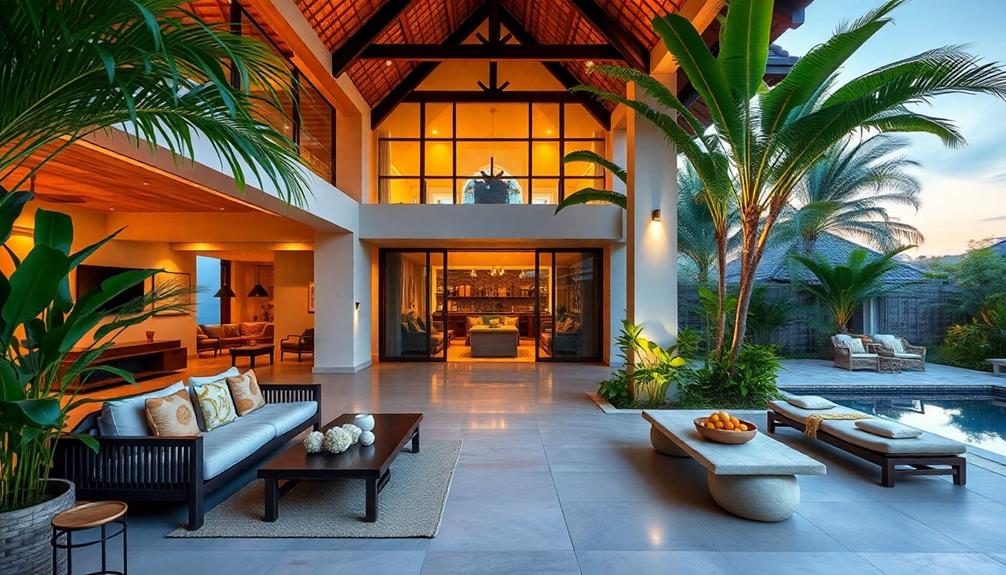
Embracing modern integration of Balinese style brings together the beauty of tropical aesthetics with contemporary living. You can create a seamless flow between indoor and outdoor spaces by opting for open floor plans and fluid layouts that enhance natural light and airflow.
Incorporating natural materials like bamboo, teak, and stone not only fosters a warm and serene atmosphere but also reflects the tropical essence of Bali. This approach is essential in achieving modern tropical aesthetics, where lush greenery harmonizes with architectural elements.
To capture that relaxed vibe, consider using low-profile furniture and oversized cushions, which encourage social interaction while maximizing your space. Vibrant accents inspired by Bali's lush flora, combined with neutral earthy tones, will create visually striking interiors that maintain a tranquil atmosphere and culturally rich environment.
Moreover, eco-friendly practices are essential in this modern integration. Using locally sourced materials and integrating sustainable technologies, like solar panels, not only aligns with the Balinese philosophy of harmony with nature but also enhances your home's comfort and appeal.
Sustainability in Balinese Home Design
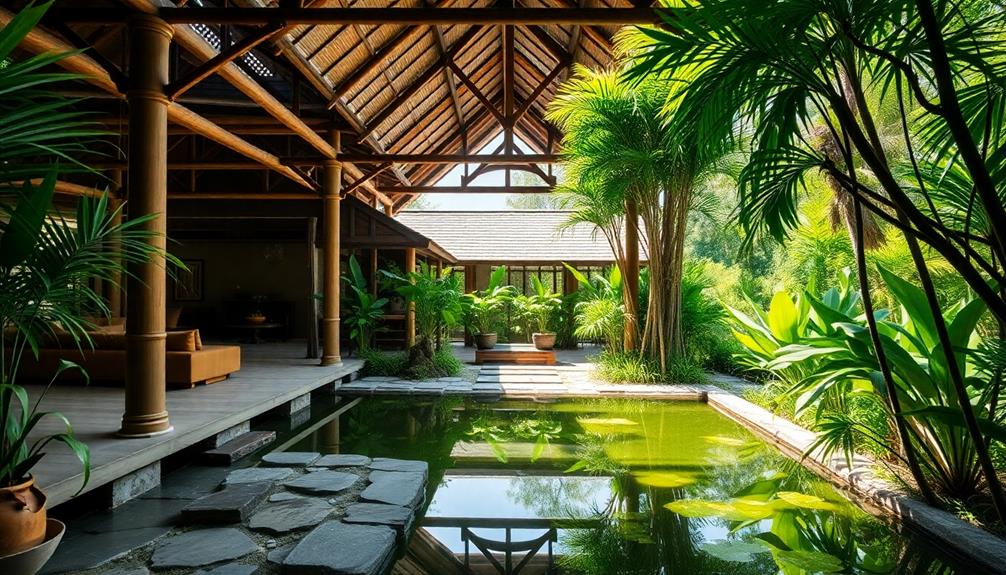
Balinese home design emphasizes sustainability through the use of eco-friendly materials like bamboo and volcanic stone, which cut down on transportation emissions.
Incorporating sustainable design practices further enhances the connection between the home and its natural surroundings.
You'll find that energy-efficient practices, such as open-air layouts, keep your home cool naturally, slashing energy bills.
Plus, integrating water conservation techniques, like rainwater harvesting, not only supports the environment but also enhances your self-sufficiency.
Eco-Friendly Materials Usage
Sustainability is at the heart of modern home design in Bali, where eco-friendly materials are thoughtfully integrated into every aspect of construction. By utilizing locally sourced materials, you not only support the local economy but also minimize your carbon footprint.
Traditional Balinese architecture showcases the beauty of traditional Indonesian housing:
- Bamboo and teak, providing natural strength and elegance
- Thatched roofs made from palm fronds, offering durability and a tropical aesthetic
- Water features like ponds and pools, enhancing biodiversity and tranquility
Open-air designs are another hallmark of Balinese homes, promoting passive cooling and reducing reliance on air conditioning.
This approach fosters a lifestyle rooted in eco-friendly living while maintaining comfort. Additionally, solar panels and rainwater harvesting systems can easily be incorporated, further enhancing your home's sustainability.
Energy Efficiency Practices
Incorporating energy efficiency practices into your home design complements the eco-friendly materials already being used. You can achieve this by embracing passive cooling techniques, such as open-air layouts and high ceilings. These features reduce the need for artificial air conditioning, ultimately lowering your energy costs. Additionally, using locally sourced materials like bamboo and thatched roofs enhances sustainability, as they have a lower carbon footprint compared to imported options.
Integrating solar panels into your design provides renewable energy, which boosts energy efficiency while decreasing reliance on fossil fuels. Thatched roofs not only add aesthetic appeal but also offer excellent insulation and durability against tropical storms, minimizing long-term maintenance and energy expenses.
Here's a quick overview of energy efficiency practices:
| Feature | Benefits | Impact on Sustainability |
|---|---|---|
| Passive Cooling | Reduces energy costs | Lowers reliance on artificial cooling |
| Solar Panels | Provides renewable energy | Decreases fossil fuel dependency |
| Thatched Roofs | Excellent insulation, durability | Utilizes sustainable, natural materials |
Water Conservation Techniques
Water conservation techniques are essential in modern home design, especially in regions like Bali where water resources can be scarce. By integrating these methods, you can create a luxurious yet eco-friendly living space.
Traditional Indonesian houses often incorporate natural materials and sustainable practices, which can inspire your own design choices for traditional housing designs.
- Rainwater harvesting systems collect and store rainwater for irrigation, reducing your overall water consumption.
- Permeable materials for pathways and patios encourage groundwater recharge, minimizing runoff and supporting local ecosystems.
- Drought-resistant landscaping featuring native plants not only beautifies your home but also cuts down on irrigation needs, aligning with sustainable practices.
Many Balinese homes include ponds and water gardens, which serve as a natural irrigation system for surrounding landscapes.
Traditional thatched roofs are designed to channel heavy rainfall into storage systems, ensuring you have water when you need it.
By embracing these water conservation techniques, you not only enhance your home's aesthetic appeal but also contribute to the preservation of Bali's unique environment.
Implementing these sustainable practices helps you enjoy a tranquil lifestyle while nurturing the land around you.
Frequently Asked Questions
What Are the Principles of Balinese Architecture?
Balinese architecture emphasizes open spaces, natural materials, and high ceilings. You'll notice intricate carvings, large windows for airflow, and water features promoting tranquility. These elements create harmony between your living space and the surrounding environment.
What Are the Characteristics of Balinese Houses?
Picture a serene sanctuary; Balinese houses blend open spaces, natural materials, and intricate carvings. You'll find courtyards inviting harmony, while water features whisper tranquility, creating a unique connection with nature and cultural heritage.
What Does a Typical House in Bali Look Like?
A typical house in Bali features an open layout, natural materials like bamboo and teak, and vibrant wood carvings. You'll find courtyards and water elements that create a serene, inviting atmosphere for relaxation and gatherings.
What Is the Balinese Theme?
The Balinese theme embraces natural materials like wood and stone, creating harmony with nature. You'll find earthy colors, intricate carvings, and open spaces that promote tranquility, inviting a serene atmosphere into your living environment.
Conclusion
Incorporating Balinese style into your home creates a beautiful contrast between luxury and simplicity. You'll find tranquility in its serene design, while still enjoying the richness of cultural details. By blending essential materials and a thoughtful color palette, you can achieve a space that feels both grounded and elevated. Embrace the elegance of wood carvings and sustainable practices, and you'll transform your living environment into a peaceful oasis that reflects both your style and values.
